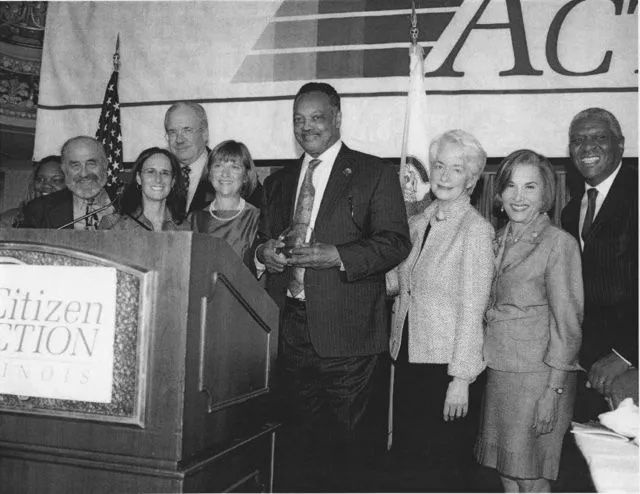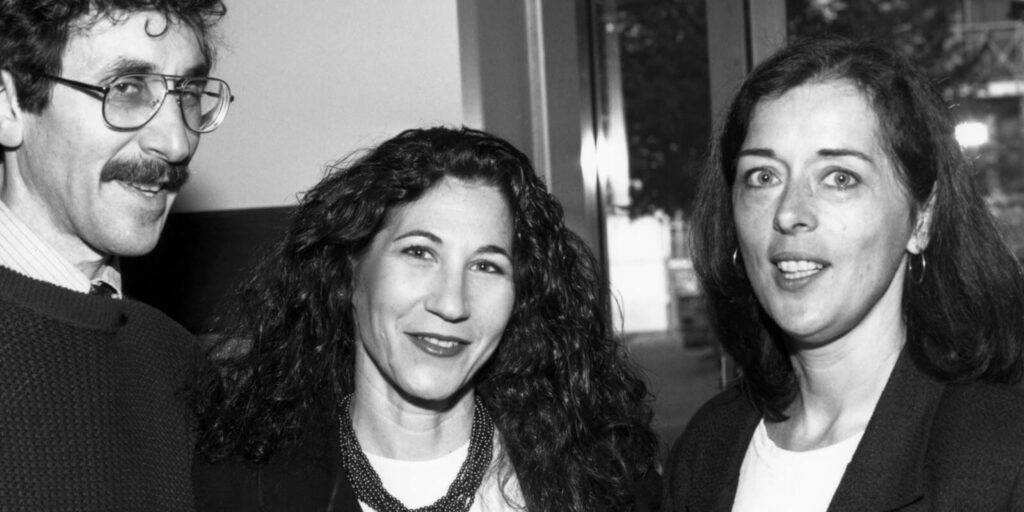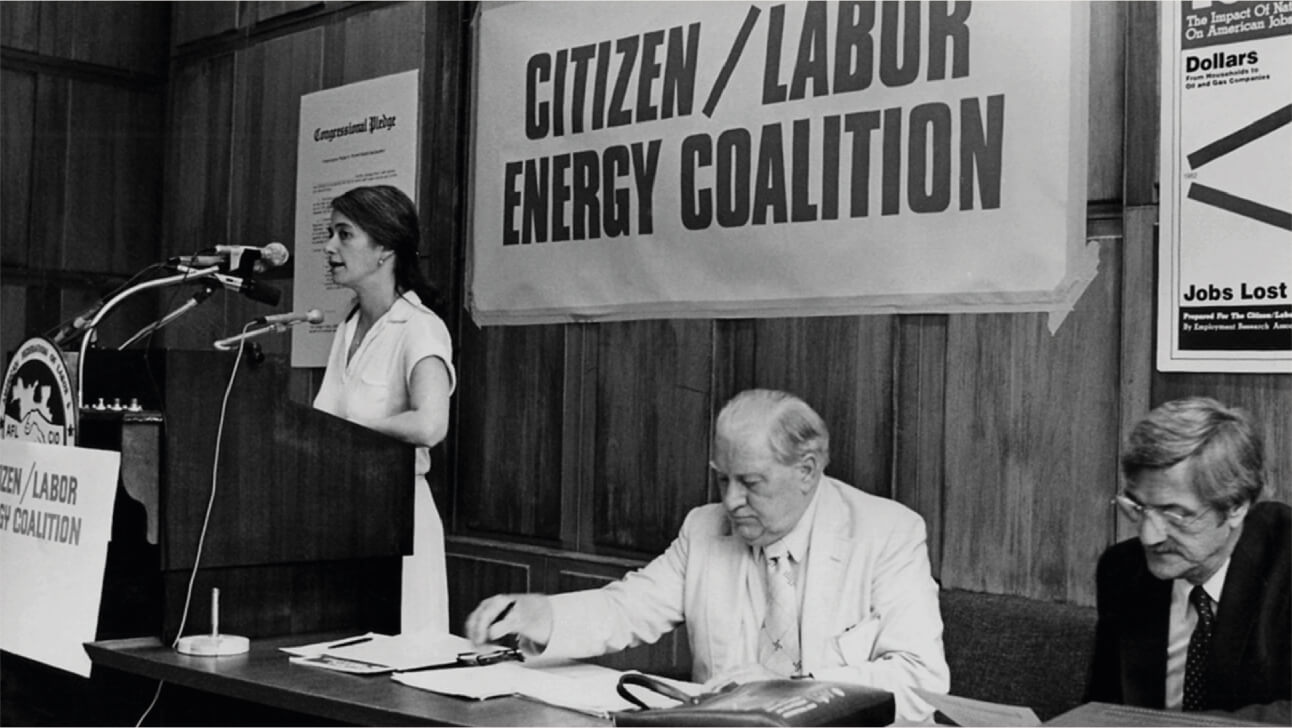

Freedom Summer
In high school, Heather Tobis (who later marries Paul Booth, a founder of Students for a Democratic Society and the Chicago Citizens Action Program) joins the Congress on Racial Equality (CORE) to protest racial discrimination. As an undergraduate at the University of Chicago, she travels to Mississippi to register Black voters and set up freedom schools and libraries with Fannie Lou Hamer and other organizers for the Student Nonviolent Coordinating Committee (SNCC).


Expanded Housing Organizing
Gale and Shel, together with thousands of community leaders at OBA, Northwest Community Organization, and Our Lady of Angels founded the West Site Coalition to deal with redlining, blockbusting and panic peddling happening across neighborhoods.

The First Conference
368 community groups from 38 states sent 1,600 delegates to the First National Housing conference in Chicago. Senator Charles Percy, Mayor Richard J. Daley, and presidential candidate George McGovern all attend. Follow-up meeting in Baltimore forms National People’s Action on Housing (NPAH) and the Housing Training and Information Center (HTIC). The HTIC board votes to hire Cincotta as Executive Director, Trapp as Training Director, and Anne-Marie Douglas as secretary.
NPAH and HTIC’s first national action is in Washington, D.C., where it targets HUD Secretary George Romney.


Passing the Home Mortgage Disclosure Act (HMDA)
Senator William Proxmire (D-WI) holds committee hearings on S1281, HMDA. Cincotta testified before Representative St Germain’s sub-committee in favor of HMDA. Cincotta is the only Community person invited to testify on FHA abuses before the U.S. Senate’s Committee on Banking & Urban Affairs and U.S. House Committee on Banking Operations Sub-committee on Manpower & Housing. HMDA passes Senate 45 to 37, and a December 12th Joint committee resolves HMDA bill which passes the Senate again on December 15th and the House on December 18th. President Ford signed the HMDA on January 3, 1976. For good measure, Illinois passed the Fairness and Lending Bill making redlining illegal in the State of Illinois; legislation requires disclosure of savings and lending data and limits relocation of savings and loan associations.

Love Canal
The story of the Center for Health, Environment & Justice (CHEJ) starts with Lois Gibbs in Niagara Falls, New York. In 1978, Lois was struggling to raise a family that included two children suffering from a variety of rare illnesses. Nearly every family in the now-infamous Love Canal neighborhood was facing its own medical nightmare. When Lois discovered that her home and those of her neighbors sat beside 21,000 tons of toxic chemicals, she led her community in a three-year struggle to protect their families from the hazardous waste buried in their backyards. Lois and her neighbors developed the strategies and methods to educate and organize the community, assess the impacts of toxic wastes on their health, and challenge corporate and government policies on the dumping of hazardous materials. 833 Love Canal households were relocated but 20,000 tons of waste are still buried there.

Citizen Action Founded
In December 1979, organizers from five state organizations came together with Midwest Academy, C/LEC, and the Cooperative Alliance to found Citizen Action. Citizen Action organizers and leaders came out of the civil rights, women’s movements, student movements, consumer rights, community organizing, the anti-war movement, and feminist movements of the previous two decades. A national strategy was needed to advance a progressive populist economic agenda that could unite majorities and address white backlash to civil rights. The focus of the founding state coalitions was multiracial working-class organizing on majoritarian economic issues. The founding groups are Massachusetts Fair Share, Illinois Public Action Council, Ohio Public Interest Campaign, Oregon Fair Share, and Indiana Citizen Action Coalition. Others soon join as well: New Hampshire People’s Alliance, Pennsylvania Public Interest Campaign, and Minnesota COACT, eventually reaching 36 statewide groups at its peak.

Superfund Becomes Law
Superfund legislation, which forces polluters to pay to clean up toxic waste sites, passes as a direct result of the efforts of the “Mother of Superfund,” Lois Gibbs, and her neighbors at Love Canal. The Comprehensive Environmental Response, Compensation, and Liability Act (CERCLA) of 1980, or Superfund, is designed to grant authority to the Environmental Protection Agency (EPA), states, and Native American tribes to manage and clean up the nation’s most dangerous waste sites. Superfund gives the EPA the responsibility to address acute local and national environmental emergencies that threaten public health and the environment. Most importantly, Superfund creates a system where polluters have to pay for the messes they create. The EPA identifies the potentially responsible parties (PRPs) that created hazardous sites and requires them to fund and/or manage the cleanups.

National Campaign Against Toxic Hazards
On February 13, 1984, with simultaneous news conferences in Washington, D.C., and fifty-four other cities, a coalition of more than one hundred groups organized by Citizen Action, Clean Water Action Project, and the Citizens’ Clearinghouse on Hazardous Waste (now CHEJ) announces the National Campaign Against Toxic Hazards. In 1985 the campaign fought for changes in the Superfund to make it more effective, then stopped the Reagan administration and the chemical industry from weakening the Superfund with a federal Right-to-Know standard that would have pre-empted stronger state and local laws. In more than 200 congressional districts, organizers made the fight over Superfund an issue in the 1984 elections. Many opponents of increases in funding for federal cleanup switch their positions. In 1984, over twelve million homes were contacted about toxic waste and the fight for Superfund through Citizen Action canvasses.

The Right to Know
By the summer of 1985, more than sixty local communities and thirty states had passed Right-to-Know legislation, with core support from CHEJ and Citizen Action. These laws require local industries to report their emissions of certain toxic chemicals and enable people to find out what chemicals were being released, stored, and disposed of in their communities. This locally-tailored data was often crucial to groups’ cleanup efforts. As local successes accumulated, so did the pressure for federal action; the Emergency Planning and Community Right-to-Know Act of 1986 (commonly referred to as Right-to-Know) law was passed by Congress. Right to Know chief sponsor Rep. Bob Edgar (D-PA) worked with PA Citizen Action to win a primary for the US Senate on the strength of this win.

Emergency Drive for Healthcare
Citizen Action, Jobs with Justice, and Families USA launch a campaign for universal quality health care with five ambulance caravans that stop in all forty-eight contiguous states, holding press conferences and rallies in each. The national campaign is modeled after an action by Citizen Action of New York, in which ambulances from throughout the state converged in Albany. The campaign kicked off on September 19th in Los Angeles, Portland, Seattle, and Minneapolis, with all of the ambulances converging in Washington, D.C. on October 10th with a huge rally and hundreds of thousands of postcards, letters, and petitions demanding universal quality health care. Citizen Action and state affiliates are at the center of the fight for universal health care, with an impressive list of state-level victories. Citizen Action wins several policy fights with the Clinton administration and Congress, and meets in the Cabinet Room with the Health Care Task Force’s Hillary Clinton, Vice President Al Gore, and others, and moves numerous members of Congress to support universal quality healthcare.
National Voter Registration Campaign
USAction conducts a massive nonpartisan voter registration effort in eighteen states that results in 500,000 new registered voters. This puts USAction on the map among national progressive organizations, and is the main focus of many statewide affiliates in 2004. For example, Maine People’s Alliance registers 12,000 people in 2004, a previously unheard-of level of political engagement in the state (there were a total of 916,139 eligible voters that year, making this effort a historic increase in eligible voters of 1.3% in the state that year).
PVC Campaign
The PVC Campaign is launched, raising the public’s awareness of the health hazards posed by PVC and convincing businesses to incorporate safer materials into their products and packaging. In 2005, CHEJ’s PVC campaign, in collaboration with a nationwide network, convinced Crabtree & Evelyn, Target, Sears, Kmart, Microsoft, J.C. Penney, Best Buy and other corporations to phase out PVC out of their products and packaging. In 2008, thanks to advocacy from CHEJ and its network of grassroots environmental organizations and allies, the Consumer Product Safety Improvement Act (CPSIA) was passed and signed into law. This Act permanently bans the sale, after February 10, 2009, of toys and child care products that contain certain phthalates and lead. The law phases out PVC, phthalates, and BPA in products and packaging, transforming consumer purchases and dividing the chemical industry lobby.
The National Healthcare Campaign
Health Care for America Now was conceived in a January 2007 meeting in the Washington, D.C., office of USAction with Richard Kirsch (Co-Executive Director of Citizen Action of NY), Jeff Blum (ED of USAction), and Alan Charney (Political Director of USAction). Private health insurance would need to be regulated, to stop companies from discriminatory practices like refusing to cover people with preexisting conditions or charging more for people who have health problems. And Medicare’s benefit package would need to be brought up to the level of private insurance, including offering prescription drug coverage and limiting out-of-pocket costs. This became the blueprint for the HCAN statement of principles that founding members USAction, SEIU, and AFCME used to recruit the AFL-CIO, Center for Community Change (now Community Change), Campaign for America’s Future, Moveon.org, and the Northwest Federation of Community Organizations (now Alliance for a Just Society). The campaign recruits over 1,000 national and state groups.

Winning The Passage of The Affordable Care Act
HCAN organizes millions of people to take action over three years, culminating in the passage of the Patient Protection and Affordable Care Act of 2010, legislation that now covers thirty-two million Americans and saves thousands of lives each year. HCAN brings a large number of major national organizations into a well-financed, strategic campaign that mobilizes Americans at the grassroots through a field campaign powered by existing state and local organizing groups. USAction, ACORN, Community Change, and NWFCO collaborate on a joint field plan that maximized their collective and individual strengths. From the national director to the national field director and the most active state groups, USAction played a central role in the campaign and victory.




Vaccine Justice
Members from People’s Action Institute groups come to New York City from across the country – Maine, Maryland, Wisconsin, Illinois, Alabama and six other states – where they blocked traffic at Pfizer Pharmaceuticals’ 42nd Street headquarters with members of Justice is Global’s End the Pandemic Everywhere coalition to demand vaccines for all. This pressure opens the door to the distribution of patent-free COVID vaccines, millions of doses of which have since been distributed worldwide.









